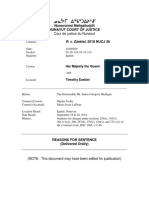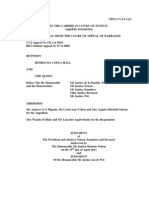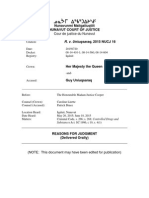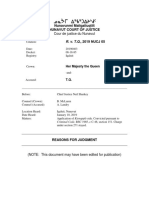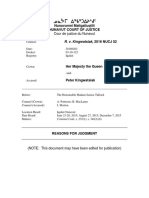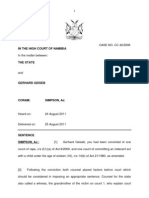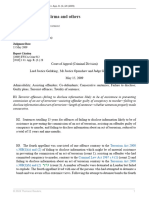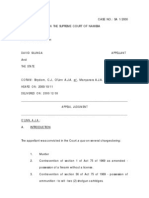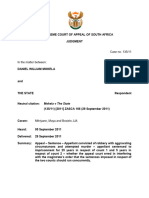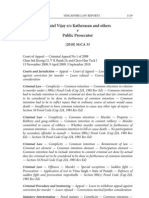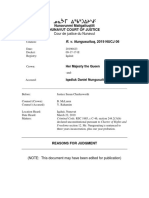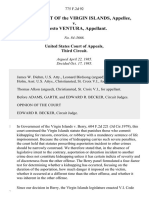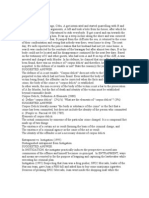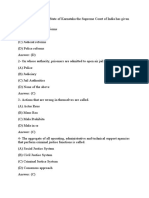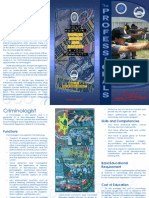2015 NUCJ 10 RvGeetah
2015 NUCJ 10 RvGeetah
Uploaded by
janeg6874Copyright:
Available Formats
2015 NUCJ 10 RvGeetah
2015 NUCJ 10 RvGeetah
Uploaded by
janeg6874Original Description:
Copyright
Available Formats
Share this document
Did you find this document useful?
Is this content inappropriate?
Copyright:
Available Formats
2015 NUCJ 10 RvGeetah
2015 NUCJ 10 RvGeetah
Uploaded by
janeg6874Copyright:
Available Formats
Nunavunmi Maligaliuqtiit
NUNAVUT COURT OF JUSTICE
Cour de justice du Nunavut
Citation:
R. v. Geetah, 2015 NUCJ 10
Date:
Docket:
Registry:
20150320
03-11-11
Iqaluit
Crown:
Her Majesty the Queen
-and-
Accused:
Elee Geetah
________________________________________________________________________
Before:
The Honourable Mr. Justice Sharkey
Counsel (Crown):
Counsel (Accused):
B. MacLaren
J. Morton
Location Heard:
Date Heard:
Matters:
Cape Dorset, Nunavut
January 29, 2015
Criminal Code, s. 236, s. 244.2(1)(a), s. 244.2(1)(b), s.
88(1)
REASONS FOR JUDGMENT
(NOTE: This document may have been edited for publication)
DISCLAIMER PAGE
Anonymized Judgment Disclaimer:
This judgment has been anonymized at the discretion
of the authoring Justice to protect vulnerable parties.
Letters have been assigned at random.
Table of Contents
REASONS FOR JUDGMENT ................................................................................... 1
I. INTRODUCTION........................................................................................................... 4
II. PROCEDURAL BACKGROUND............................................................................... 4
III. THE SPECIFIC CHARGES & SENTENCES IMPOSED...................................... 5
IV. THE FACTS OF THE OFFENCES .......................................................................... 7
V. THE PERSONAL CIRCUMSTANCE OF THE OFFENDER............................... 11
VI. THE POSITION OF THE PARTIES ...................................................................... 12
A. Crown ...................................................................................................................... 12
B. Defence ................................................................................................................... 17
VI. ANALYSIS & CONCLUSIONS ............................................................................... 21
I. INTRODUCTION
[1]
On January 29, 2015, in Cape Dorset, I imposed a fifteen (15) year
term of imprisonment upon Elee Geetah.
[2]
I did so after hearing the comprehensive and helpful submissions of
counsel.
[3]
I felt it was important that the accused, his family, and the community
all know the sentence imposed before the Court left the community.
[4]
I did, however, advise counsel that I would provide written reasons for
judgment to follow shortly.
[5]
Accordingly, what follows are my reasons for the fifteen year sentence
imposed.
II. PROCEDURAL BACKGROUND
[6]
I sentenced Elee Geetah on a charge of manslaughter, as well as
numerous charges involving the use and possession of firearms.
[7]
All the charges arose from an incident, or series of events, which took
place on the same day.
[8]
Originally, Mr. Geetah was charged with murder. He elected to be
tried by a judge without jury and the trial proceeded before me.
[9]
At trial, I found Mr. Geetah not guilty of murder, but guilty of the lesser
included offence of manslaughter.
[10] Mr. Geetah has always admitted the killing.
[11] It is not in dispute between the parties (Crown and Defence) that from
early in the proceedings Mr. Geetah would have pleaded guilty to
manslaughter had the Crown allowed it by agreeing to such a plea.
[12] The Crown, however, and quite legitimately, would not consent to a
manslaughter disposition and so the case proceeded to trial.
[13] Similarly, it is not in dispute that Mr. Geetah had intended, from early
on in the proceedings, to plead guilty to some of the firearms charges
he faced. The pleas in relation to these charges were simply held in
abeyance or put off pending the outcome of the murder trial.
[14] At the conclusion of the murder trial, the Crown presented an
Indictment containing the four most appropriate firearms charges to
which Mr. Geetah then pleaded guilty.
III. THE SPECIFIC CHARGES & SENTENCES IMPOSED
[15] The specific offences, and the sentences imposed, are as follows:
1) Manslaughter, contrary to section 236 of the Criminal
Code, RSC 1985, c C-46 [Criminal Code] [Indictment # 2]:
Ten (10) years imprisonment.
2) Intentional discharge of a firearm into a residence,
contrary to Criminal Code s. 244.2(1)(a) involving
Constable Robert Driscolls house [Indictment # 3, count 3]:
Five (5) years imprisonment to be served consecutive to
the term of imprisonment imposed for manslaughter.
3) Intentional discharge of a firearm while being reckless
as to the life and safety of others, contrary to Criminal
Code s. 244.2(1)(b), involving victims A.E., G.P., and E.P.
[Indictment # 3, count 1]: Four (4) years imprisonment to be
served consecutive to the term of imprisonment imposed
for the manslaughter sentence, but concurrently with all
other sentences imposed.
4) Intentional discharge of a firearm while being reckless
as to the life and safety of others, contrary to Criminal
Code s. 244.2(1)(b), involving victims M.P. and S.L.
[Indictment # 3, count 2]: Four (4) years imprisonment to be
served consecutive to the manslaughter sentence, but
concurrently with all other sentences imposed.
5) Possession of a weapon (firearms and ammunition) for
a purpose dangerous to the public peace, contrary to
Criminal Code s. 88(1) [Indictment # 3, count 4]: One (1)
year imprisonment to be served consecutive to the
manslaughter sentence but concurrently with all other
sentences imposed.
[16] The total sentence imposed for all offences is fifteen (15) years.
Further, and to be clear: while the firearm offences as a group are
imposed consecutive to the manslaughter sentence, they are to be
served concurrently with each other. The offence contrary to Criminal
Code s. 244.2 (1)(a), involving the Driscoll residence is the so-called
lead firearm offence where I imposed the five (5) year sentence to run
consecutive to the manslaughter sentence. All other firearm
sentences are to be served concurrently with this lead firearm
offence, and thus the aggregate sentence is fifteen (15) years.
[17] Regarding remand credit, the situation is as follows. Mr. Geetahs
actual time served on remand was four (4) years and 3 months. The
Crown did not dispute the Defence request for enhanced remand
credit at a ratio of one point five (1.5) to one (1). Accordingly, I
granted such enhanced remand for each full year served and nonenhanced credit for the additional three (3) months. Thus, the total
remand credit granted was six (6) years and three (3) months.
[18] The net sentence to be served by Mr. Geetah, moving forward from
January 29, 2015, is nine (9) years less three (3) months, or, more
precisely as a positive calculation, eight (8) years and nine (9)
months.
[19] Prior to the incident which gave rise to these charges, Mr. Geetah had
no record of previous conviction.
[20] However, all the offences, save and except the charge of possession
of a firearm in breach of the public peace contrary to Criminal Code s.
88 (1), have minimum sentences which must be imposed by the
Court.
[21] The manslaughter charge attracts a four (4) year minimum sentence
pursuant to Criminal Code s. 236 (a) because a firearm was involved.
[22] The two (2) offences of intentionally discharging a firearm while being
reckless as to the life and safety of another person contrary to
Criminal Code s. 244.2(1)(b) carries a minimum sentence of four (4)
years for a first offence.
[23] Similarly, the offence of discharging a firearm into a residence
knowing that or being reckless as to whether another person is in the
residence contrary to Criminal Code s. 244.2(1)(a), also carries a
minimum sentence of four (4) years.
[24] I pause to note that during the hearing, both Crown and Defence
counsel were of the belief that the offence contrary to Criminal Code
s. 244.2(1)(a) (shooting into a residence) carried a minimum sentence
of five (5) years imprisonment. Indeed it does, but only if a restricted
weapon is used or if a criminal organization is involved, which is not
the case here. I did not take time, during the hearing, to clarify and
correct counsels misunderstanding. I should have done so, but I note
as well that this misunderstanding on counsels part in no way affects
the end result of the sentences imposed.
[25] In addition to the sentences imposed, I also made various Ancillary
Orders. I ordered that Mr. Geetah provide a DNA sample. I made a
forfeiture order respecting the firearms involved. I made a fifteen (15)
year firearm order pursuant to s. 109 of the Criminal Code, with no
exception for subsistence hunting. Finally, because of the date of the
offences the law allowed me to waive the victim fine surcharge, which
I did given the length of the sentence imposed.
IV. THE FACTS OF THE OFFENCES
[26] A comprehensive review of the facts regarding the manslaughter
verdict is contained in my judgment respecting Elees criminal liability:
R v Geetah, 2014 NUCJ 23, [2014] Nu J No 16 (QL).
[27] Nonetheless, in order to give context to the sentences imposed, I feel
it necessary to briefly revisit the facts of the manslaughter scenario.
[28] Further, during the trial the only evidence about what Elee did in the
aftermath of the killing came from Elees testimony and his statement
to Constable Daley. At the sentencing hearing a week or so ago,
however, the Crown provided detail about this from the perspective of
the victims and the community.
[29] Elee shot and killed his older brother, Jamesie, October 10, 2010, in
Cape Dorset. Elee was 19 years old at the time. Jamesie was 23. The
killing took place in the familys two story home, in the early afternoon,
shortly after lunch. Elee and Jamesie were in the house, along with
their siblings, and their uncle. The parents were not home at the time.
[30] The fatal shot was a single blast from a 20 gauge pump action
shotgun. It hit Jamesie on the top right side of his head, and death
was instantaneous. Everybody was sober. There was no alcohol or
other intoxicants involved.
[31] In the year or so before the shooting, Elee had been having suicidal
thoughts in particular because of the death of his best friend who
had committed suicide. In the hour or so before the shooting, Elee
had been having a bad day. He was not getting along with people and
he had done some minor damage to the house.
[32] Eventually, Elee just decided to leave. However, Jamesie did not want
Elee to leave the house, likely because he wanted Elee to wait until
their parents came home and account for the damage he had done.
[33] As Elee was going out the door he was surprised by Jamesie, who
punched him, jumped on him, and pinned him to the floor. A small
scuffle ensued, but their uncle, Ohituq, pulled the boys apart and put
an end to it.
[34] Jamesies ambush, however, set Elee off drastically into a mad rage.
Elee said nothing, but he did a lot in the space of only a few minutes.
[35] There were a number of firearms kept in the laundry room on the first
floor of the house. Elee went into the laundry room, picked up and
loaded the 20 gauge pump action shotgun. However, he put only 2
shells into the magazine.
[36] After the scuffle with Elee, Jamesie had gone into the kitchen. He was
preparing some food and boasting about how easily he had been able
to put Elee down. It does not appear, however, that Elee heard any of
this boasting.
[37] Elee was pre-occupied with something else. He walked out of the
laundry room and into the living room, at the same time working the
pump action and moving a live shell into the firing chamber.
[38] From where he stood in the living room, slightly behind or just to the
side of a support column in the house which was used as a coat rack,
Elee fired a shot in the general direction of the front door of the house,
which is adjacent to the kitchen entrance.
[39] Elee testified that the reason he fired the shot was to scare everybody
and get them to run out of the house after which, he said, he intended
to use the remaining round in the shotgun to kill him.
[40] The sound of a round being chambered in a pump action shotgun is
something that Jamesie was familiar with. Jamesie had barely (if at
all) stepped out of the kitchen, when, almost simultaneously, Elee
pulled the trigger, from about 10 to 14 feet away.
[41] Jamesie went down immediately. Elees uncle, Ohituq, and his
younger brother, Alex, rushed to take the shotgun away from Elee,
but he would not let go. In the struggle, the shotgun discharged
accidentally, but did not hurt anyone. Eventually, the shotgun was
pried away from Elee and he implored his uncle to kill him.
[42] Everybody then fled the house leaving Elee alone with his deceased
brother Jamesie.
[43] Elee then went upstairs to his parents bedroom where his father had
a number of high powered rifles stored away. Elee then began firing
shots out the window with these various different high calibre firearms
(one of which, a 223, had a telescopic sight).
[44] The house itself is on high ground in Cape Dorset and, from his
vantage point at the second story window, Elee had a panoramic view
of the community.
[45] Elee fired a number of rounds; the exact figure is not clear, but
certainly he fired more than a dozen, and perhaps as many as thirty
shots.
[46] It is not in dispute that Elee was a good shot, nor is it in dispute that
he was not actually trying to shoot anyone walking along the street.
[47] Elee testified that he fired a number of rounds intentionally in front of
and beside some women who were walking on the roadway. These
rounds hit either the ground in front of the women, or a wooden
stairway beside them which was exactly where Elee was aiming.
10
[48] Elee also fired a number of shots at two trucks. The driver of the first
truck, S.L., had parked or pulled over when he saw Royal Canadian
Mounted Police [RCMP] officers taking up defensive positions. S.L.
heard a shot and then a second shot which hit the front side of his
truck, and then, as he backed away from the scene, another round
penetrated the front grill.
[49] At this point, S.L. was also warning other people to stay away when a
second truck, driven by M.P., pulled up. M.P. stepped out of his truck
briefly to see what was happening, at which point a round hit the side
of his vehicle fairly close to M.P.s head. Then, as M.P. got back into
his truck, Elee fired 4 rounds into the vehicle itself.
[50] A.E. is a young woman who was just walking over to a friends place,
with a baby in her amauti, when all of a sudden gunfire erupted and
shots started landing in front of and behind her. A.E. was fearful the
baby had been shot, but even in her panicked state, and as shots
continued to rain down near her, she was able to take the baby from
the amauti and run to a nearby house for safety.
[51] Another woman in the vicinity, E.P., heard shots and from her front
porch warned A.E. to get out of the street. E.P. was concerned about
the whereabouts and safety of her children and just as she came
down the steps of her porch she was hit with splintered wood from a
bullets impact on the stairs.
[52] G.P. was another woman who was just walking along the street;
people reported that they saw G.P. running for cover as bullets hit the
ground around her.
[53] This shooting spree went on for some time. Again, Elee was a good
shot he picked off a raven some 200 yards away and he also killed
a dog. At one point it was believed that this dog was a family pet, but
this turned out not to be the case, it was apparently a loose or stray
dog.
[54] The word was out within the community that there was a shooter on
the loose; indeed, in such a small community people could hear the
shots. But beyond that they really didnt know who the shooter was or
where he was. People phoned and used social media to find out what
was going on and some families even loaded their own firearms in
preparation for the worst.
11
[55] There were 3 RCMP officers stationed in Cape Dorset. Two of them
had taken up observation positions outside the Geetah residence as
Elee fired away.
[56] The RCMP residential compound is easily visible from the Geetah
house and Elee had a birds eye and clear view of one of these
houses Constable Driscolls house.
[57] Constable Driscoll was one of the 2 officers watching the Geetah
house. Constable Driscolls wife and 2 small children were at home,
along with the wife of the other officer who was with Constable
Driscoll watching the Geetah house.
[58] Elee fired a shot with one of the high powered rifles into the Driscoll
home. The bullet went through an exterior wall, through the kitchen,
and into the opposite exterior wall. Luckily, no one was in the kitchen.
[59] At his trial, Elee testified that the reason he fired all these shots was
to create a dangerous situation in the hope that the RCMP would feel
they needed to kill him.
[60] In addition to firing shots out the window, Elee also spoke briefly on
the phone with his older sister and her husband; he also chatted with
them online for a short time. He told them he was sorry and wanted to
know where his mother was. He also told them he was feeling
suicidal. They told him to give himself up to the police.
[61] What followed over the course of a few hours was an all too typical
stand-off as police tried to persuade Elee to surrender himself into
custody.
[62] The stand-off came to an end without further incident as an RCMP
crisis negotiator was able to persuade Elee to turn himself in.
V. THE PERSONAL CIRCUMSTANCE OF THE OFFENDER
[63] Elee Geetah was 19 years old when he committed the offences; he is
now 23 years old. He comes before the Court with no record of
previous conviction. He was, however, found guilty of simple assault
in August of 2011, as a result of an incident that occurred while he
was on remand.
12
[64] Defence counsel tells me that Elee is from a large family his father,
David, and his mother, Saila, have 7 other children in addition to Elee.
At one point Elee was adopted out to his paternal grandmother, but
returned home to live with David and Saila (which is where he was
living when he committed the offences).
[65] Defence counsel tells me that Elees father, David, is a product of the
residential school system, and that when Elee was young he saw a lot
of alcohol abuse in the family to the point where he would have to
leave home for a few days. Defence counsel also advises that Elee
himself had a problem sniffing gas when he was young.
[66] In recent years, however, the Geetah home appears to have settled
down, and Defence counsel describes it as a good home a
household well attuned to the traditional Inuit life, and the kind of
place where, as counsel says, prior to October 10, 2010, you
wouldnt expect would have any problems involving the police.
Defence counsel tells me that prior to that tragic day, Elee would
regularly attend church with the rest of his family.
[67] Elees father David makes a living from carving and his mother Saila
takes care of the household. Indeed, on the very morning of
Jamesies tragic death, the family was down at the beach readying
their boats for a trip the next day.
[68] Counsel describes Elee, prior to October 10, 2010, as a law abiding,
but inexperienced young man essentially a good boy. I am told that
Elee did relatively well in school, and had fairly regular employment
prior to October 10, 2010.
[69] Defence counsel also noted (and we heard much about this at the
trial) how the loss of his closest friend, to suicide in 2009, had left a
serious mark on Elees psyche.
VI. THE POSITION OF THE PARTIES
A. Crown
[70] First, respecting manslaughter, the Crown acknowledges the finding
of the Court at trial, that when Elee fired the fatal shot he did not
intend to kill Jamesie, and therefore in law, he did not have the
required intent for murder.
13
[71] Nonetheless, the Crown says that up to that point before he pulled
the trigger - what Elee did was done deliberately, knowingly, and
when he was completely sober. This, says the Crown, should serve to
aggravate the sentence.
[72] Specifically, the Crown notes how, as a result of his anger, Elee went
to the laundry room, chose his weapon, loaded it, and stepped into
the living room with the intention of firing the shotgun off inside the
house.
[73] Indeed, the Crown notes that Elees expressed intention was to scare
his family members (his brother Jamesie, his younger siblings, and
his uncle Ohituq) out of the house by firing the shotgun.
[74] The Crown says that Elees selfish and deliberate behavior was
something that he could have simply put a stop to at any time.
[75] It is within this deliberate context, says the Crown, that the fact
situation of this particular manslaughter may be fairly characterized as
near murder.
[76] The Crown also notes that the domestic aspect of the case should
also serve to aggravate the sentence. By analogy, the Crown
suggests that the Court should adopt or embrace the recent judicial
trend towards increasingly higher sentences for cases of spousal
manslaughter, as evidenced, for example, in the recent case of R v
Peter, 2014 NUCJ 28 [CanLII], [2014] Nu J No 26 (QL) [Peter]. In that
case, the accused, Peter, was a repeat or serial spousal assault
perpetrator. Eventually, he killed his spouse and his case proceeded
to trial for murder. At trial he was convicted of manslaughter, and
given a fifteen (15) year sentence.
[77] I pause to note that respecting my reference to any other case
precedents, where I reference the sentence or sentences imposed, I
do so without any consideration of what time may have been, at the
end of the day, deducted from the sentence as a result of time served
on remand.
[78] The Crown also suggests that sentences imposed for manslaughter
(particularly where firearms are used in a domestic context) should
reflect the statistical disparity in the homicide rate between Nunavut
and the rest of Canada, and that sentences for this type of offence
should be increased in response to such increasing tragedy.
14
[79] The Crown cited homicide rates during the sentencing hearing and
Defence counsel took no issue with the numbers or the proposition
that the Court could, at least to a certain limited extent, factor this
statistical information into the ultimate sentence.
[80] The Crown cited statistics from 2011. But I would note, for example,
that for 2013, Nunavuts homicide rate, expressed as a per capita
ratio, was 11.24 per 100,000 of the population. Canadas rate, on the
other hand, stood at 1.44 per 100,000.
[81] It is the Crowns position that the legal climate has changed since the
case of R v Elias, 2006 NWTSC 41 [CanLII], 70 WCB (2d) 869 [Elias],
one of the authorities relied upon by the Defence. In that case, the
forty-two (42) year old accused, Elias, in a drunken rage, shot and
killed his younger brother and wounded another man. He also had a
previous, but relatively minor, criminal record. Mr. Elias pleaded guilty
and received a sentence of six (6) years imprisonment.
[82] It is the Crowns position that the sentence imposed must, from a
denunciatory and deterrent standpoint, reflect the proliferation in the
last decade of firearm crime in Cape Dorset.
[83] Accordingly, in relation to the offence of manslaughter, the Crown
urges the Court to impose a term of imprisonment of between eight
(8) to ten (10) years.
[84] The Crown says their position respecting an eight (8) to ten (10) year
sentence for the manslaughter offence is attenuated by the fact that
this young accused faces four (4) other firearms offences, three of
which carry minimum four (4)-year sentences.
[85] The Crowns position respecting these other offences is further
attenuated by the principle of global sentencing. The Crown is of the
view that the sentences imposed upon Elee for his shooting rampage
should run consecutive to the manslaughter sentence, but concurrent
to each other.
[86] From a legal perspective, the Crown is of the view that while the
shooting from the second story window is proximate in time to the
manslaughter, it is a sufficiently separate endeavor on Elees part to
merit the imposition of a consecutive sentence.
15
[87] The Crown also makes specific note of how the entire community was
terrorized as a result of Elees shooting spree. In this regard, I have
also had the advantage of reading the victim impact statements of the
some of the women who were out in the street when Elee started
firing.
[88] Further, and specifically in relation to Elees decision to fire a shot into
an RCMP residence, the Crown says the sentence imposed for this
offence must reflect the new reality in Nunavut of an alarming
increase in attacks upon police detachments and residences with
firearms.
[89] In this regard, the Crown reminds the Court of two notorious cases the case of R v Lyta, 2013 NUCA 10 [CanLII], 301 CCC (3d) 486
[Lyta], and the case of R v Utye, 2013 NUCJ 14 [CanLII], [2013] Nu J
No 18 (QL) [Utye], from Cape Dorsets neighbouring community,
Kimmirut.
[90] In Lyta, what happened was that the only two members of the RCMP
stationed in Kimmirut were awakened during the night, along with
members of their families, when shots were fired into their residences
(adjoining units in a duplex). An RCMP officer, his wife, and child
were present in each residence. The families took shelter in the safest
part of the house until the shooting stopped, then spent another two to
three terrifying hours trapped in their homes awaiting the arrival of
help from Iqaluit. Seven (7) of the eleven (11) shots fired by the
accused, David Lyta, from his 22 caliber rifle hit the residences.
[91] The accused, David Lyta, was 22 years old at the time, and had a
minor criminal record; prior to this shooting rampage he had a good
relationship with the RCMP. He was suicidal and drunk when he fired
the shots.
[92] He was charged with the same offence as Elee Geetah namely,
shooting into a residence knowing or being reckless as to whether it
was occupied contrary to s. 244.2(1)(a) of the Criminal Code. Lyta
pleaded guilty and was given (on an appeal by the Crown) a five (5)
year prison term.
16
[93] The other Kimmirut case of Utye has more severe facts than Lyta.
The accused, Joe Utye, positioned himself on a hill overlooking the
police detachment in the early hours of the morning and, in a drunken
rage, opened fire with a high powered 303 caliber rifle; thirteen (13)
shots penetrated the detachment, and seven (7) penetrated police
vehicles. The shots penetrated doors and walls with ease; bullets
found their way into the kitchen, bathroom, and offices of the
detachment. There were two officers and a youth inside at the time;
they could only hunker down in fear, and wait out the shooting. They
had summoned help from Iqaluit, but it would take 3 hours to arrive;
minutes seemed like hours to the victims of this attack. Eventually,
Joe Utye ceased firing and a number of citizens risked their lives as
they approached and subdued Utye as he walked home.
[94] Joe Utye was 22 years old at the time of the offence. He had a youth
court record, however, for pointing a firearm, uttering threats, and
assault with intent to resist arrest. All 3 of these offences involved
police officers. Prior to getting a rifle and ammunition, Utye had
consumed 26 ounces of vodka as well as some beer. He pleaded
guilty to the offence of recklessly discharging a firearm into a building,
and received a seven (7) year prison term.
[95] The Crown urges the Court to impose a similar sentence on Elee
Geetah. Namely, a seven (7) year jail term for the offence contrary to
Criminal Code s. 244.2(1)(a) for shooting into Constable Driscolls
residence. The Crown says that this sentence should be imposed
consecutive to the sentence of eight (8) to ten (10) years which are
suggested as the appropriate range years for the manslaughter
charge.
[96] In keeping with the need for restraint within the context of global
sentencing, the Crown then urges that the remaining firearm
sentences be imposed concurrently to the offence of shooting into the
house. The Crown suggests that these sentences should be imposed
as follows. For the offence contrary to Criminal Code s. 244.2(1)(b)
involving the occupants of the 2 trucks, the Crown suggests a six (6)
year prison term. For the offence contrary to Criminal Code s.
244.2(1)(b) involving the three women on the roadway, the Crown
suggests a five (5) year prison term. And for the offence contrary to
Criminal Code s. 88(1) of having a weapon for a purpose dangerous
to the public peace, the Crown suggests a one (1) year term of
imprisonment.
17
[97] In the end result, the Crown position globally, for all offences, is for a
term of imprisonment of between fifteen (15) to seventeen (17) years.
[98] The Crown also notes that there are two (2) mandatory ancillary
orders required. First, an order requiring the accused to provide a
DNA sample, and second, a firearm prohibition which the Crown
suggests should be for life. The Crown also asks the Court to
consider the victim fine surcharge, but points out that the date of the
offence allows for a waiver of the surcharge.
[99] Respecting Elees shooting spree generally, the Crown quite
accurately makes note of the inherent danger of ricochet when a
bullet from high powered rifles makes impact with the ground, or
enters a vehicle, or a house. The Crown suggests the Court should
take little heed of the fact Elee was a good shot and did not try to hit
anyone, nor the fact that his motive for the shooting spree was to
commit what has come to be called suicide by police. The Crown
says that such rationalization and excuse should not deter from the
seriousness of real danger as Elee fired the shots, nor the terror that
he evoked among the good citizens of Cape Dorset. Indeed, the
Crown says bluntly that as Elee fired away, from his perch up on the
second story of the house, there was no one in the community who
was not terrorized.
[100] Finally, the Crown notes that Elees shooting spree should be
viewed within the context of an ever increasing frequency of such
armed stand-offs in Nunavut and that this should aggravate the
sentence. Further in this regard, the Crown notes that many of these
stand-offs end without any shots fired at all whereas in Elees case
we have as many as two dozen shots fired.
B. Defence
[101] Respecting manslaughter, Counsel points out that the Defence
position does not differ materially from the Crowns position for an
eight (8) to ten (10) year period of imprisonment.
[102] The Defence, however, urges the Court to a consider range of
between six (6) to eight (8) years.
18
[103] Defence counsel acknowledges that the sentencing principles of
deterrence and denunciation are certainly paramount in a case such
as this, but nonetheless urges restraint for a number of mitigating
reasons.
[104] First, Defence Counsel notes the youth of the offender and
emphasizes that Elee was only 19 years old when he committed the
offences. Further, that his antecedents show not the slightest
disposition for violence. Counsel describes Elee, prior to this
incident, as a law abiding but immature youth essentially as a
good boy.
[105] Defence counsel acknowledges the limited application, in serious
cases such as this, of the remedial provisions of section 718(2)(e) of
the Criminal Code. Nonetheless, Defence counsel suggests that the
spirit of these provisions, as they have been embraced and
explained by our Supreme Court of Canada in R v Gladue, [1999] 1
SCR 688, [1999] 1 SCR 688 (QL) [Gladue], and R v Ipeelee, 2012
SCC 13, [2012] 1 SCR 433 [Ipeelee], must be brought into play in
this case at least to some extent.
[106] In this regard, counsel notes that Elees father, a product of the
residential school regime, struggled with alcohol and how this
affected Elee as a young boy, to the point where Elee himself
resorted to sniffing gasoline.
[107] Defence counsel also notes that Elee has always taken
responsibility for the killing, and has never denied the details of his
shooting spree. Counsel suggests that the situation is much akin to
the entry of a guilty plea.
[108] In this regard, Defence counsel says that his client is truly remorseful
for killing his brother, and now, with the passage of time and some
insight into his behavior after the killing, is sorry too that he terrorized
the members of his own community.
[109] I pause to note that Elee was afforded the opportunity, prior to being
sentenced, to address the Court. He did so briefly, but in my view
sincerely, to the point where I believe his remorse is real.
19
[110] Defence counsel does agree that the family context of the killing is
disturbing, but draws a distinction between this case and cases of
domestic spousal manslaughter where often a positon of trust serves
to aggravate the crime.
[111] Further, the Defence disputes the Crown characterization of this
manslaughter case as factually akin to near murder.
[112] In this regard, the Defence urges the Court to focus on Elees mental
state at the time, rather than just his actions in loading the shotgun
and pulling the trigger. Counsel suggests that the killing was an
impulsive act committed by an immature young man, in a highly
emotional state, bent on suicide.
[113] Similarly, Defence counsel says that this same state would account
for his lack of concern for other people through the danger of a stray
or ricochet bullet. It simply was not, says Defence counsel,
something that Elee was thinking about.
[114] Defence counsel understands the growing trend towards, and the
need for, denunciatory sentences for certain types of crime, and in
particular for spousal manslaughter where the accused (usually the
husband) is a repeat spousal assault offender. Defence counsel
points out that the victims death in such cases comes as a result of
years of abuse. The Defence, however, urges the Court to
distinguish these cases on the basis that Elee, unlike the serial or
repeat spousal assaulter, is simply not a hardened criminal who
harbours a vicious disposition in a domestic context.
[115] Counsel says that Elee made an appalling and grotesquely tragic
mistake. However, says counsel, terms of the individualized
approach which is a hallmark of Nunavuts sentencing regime, Elee
is by no means (unlike a serial spousal abuser) beyond redemption.
[116] Defence Counsel suggests that the proposed range of six (6) to
eight (8) years is, from a deterrent and denunciatory standpoint, still
a significant period of jail, particularly given the age and antecedents
of his client. It is also a range, says counsel, which is more in
keeping with other manslaughter cases which involves a fatal
shooting of a brother. In this regard, Defence counsel cites the case
of Elias, above, where a six (6) year sentence was imposed, and R v
Druken, 2006 NLCA 67, 215 CCC (3d) 394 (NLCA), where a five (5)
year sentence was imposed.
20
[117] Where the Defence parts company with the Crown in a major way is
how the Court should deal with the firearms offences.
[118] The Defence argues not only that a sentence in the range of six (6)
to eight (8) years is appropriate for the manslaughter offence, but
also that it should serve as the global sentence as well.
[119] Counsel suggests that the sentences for the firearms charges should
all run concurrent to the manslaughter sentence.
[120] Counsel says that what is important in this case is not the quantum
of individual sentences for the manslaughter and the firearms
charges, but rather the end of the day result the global sentence.
[121] Defence counsel says that albeit Elee is to be sentenced for a major
crime, a homicide, the individualized aspect of the sentencing
process must recognize Elees youth and crime free antecedents in
a meaningful way.
[122] This is particularly so, says Defence counsel, where the facts of
homicide and the facts of the shooting are so inextricably linked as
essentially one continuing transaction both in time and nature.
Counsel says that Elee was seeking or intent upon committing
suicide before Jamesie was shot, and seeking or intent upon having
the police come to kill him as he fired from the upper floor window.
[123] Defence counsel notes that Elees suicidal ideation never changed,
and that the shooting spree flows immediately in the aftermath of
Jamesies death.
[124] The Defence says it is well settled law that offences which occur as
part and parcel of a continuing transaction or chain of events should
attract concurrent sentences. The Defence position is that within this
context, as a matter of law, the case for concurrent sentences is
compelling.
[125] Importantly as well, says the Defence, a global disposition of a jail
term between six (6) and eight (8) years is a firm and fair range
which satisfies the sentencing objectives of deterrence and
denunciation while recognizing the potential rehabilitation of the
young accused.
21
VI. ANALYSIS & CONCLUSIONS
[126] It is well settled law that sentences imposed upon offenders can and
should reflect the concerns of citizens in a particular region of the
country, and also that the prevalence of a particular crime is a
relevant factor to taken into account in the sentencing process.
[127] An example of the application of these two notions or principles can
be found in the sentences imposed by the Nunavut Court of Justice
in cases of spousal manslaughter.
[128] The Court has moved the yardsticks, so to speak, and in the last few
years greatly increased the sentencing range in cases of spousal
manslaughter where the offender comes before the Court with a
track record for spousal assault and related abuse.
[129] For example, in R v Ammaklak, 2008 NUCJ 27, 2008 NUCJ 27
[CanLII], a 13 year sentence was imposed. In R v Kinak, 2011 NUCJ
25, [2011] Nu J No 30 (QL), a sentence of 14 years was imposed.
And recently, in the case of Peter, above, a sentence of 15 years
was imposed.
[130] These sentences reflect the reality that in Nunavut the statistical
incidence of spousal abuse far exceeds indeed, almost
exponentially exceeds the national rate. More importantly, the
Court recognizes that such exemplary sentences are needed in
order to maintain public confidence in the justice system.
[131] From a denunciatory standpoint, such sentences assure the law
abiding citizens of Nunavut that the Court shares their abhorrence
for this type of crime. The sentence is a signal that the Court takes
this type of crime spousal manslaughter seriously.
[132] In addition, and from the standpoint of general deterrence, there is
always hope that individuals who perpetrate continued and habitual
abuse upon their partners might pay heed to these sentences as
they listen to the radio news, and be motivated to seek out the family
support and professional help needed to address the underlying
causes of their misbehaviour.
[133] By analogy, the judges of this Court are well aware of the ever
increasing, and disturbing, incidence of firearm crime in Nunavut.
22
[134] Specifically, the communities of Cape Dorset and its sister
community Kimmirut have, in the last decade, been riddled with
firearm violence, including firearm violence directed at the police
(twice with fatal result).
[135] It is a sad observation that firearms, once used only as tool in the not
too distant past, are now the first resort of choice as a weapon for a
small but significant minority of frustrated and dysfunctional young
men - young men unable to deal with jealousy, anger, or suicidal
thoughts, and often driven by alcohol.
[136] The end result, when these young men reach for a rifle, is the all too
common stand-off with police.
[137] In the past such a scenario might be expected to occur a few times
within a year. Today it is not remarkable to hear of a police stand-off
with much more alarming frequency.
[138] It is within this context of increasing firearm crime in Nunavut, and
particularly in south Baffin and Cape Dorset, that Elee Geetah is
before the Court to be sentenced.
[139] Although the entire weight of this high incidence of firearm violence
cannot be placed on Elees shoulders, this contextual background
cries out for a denunciatory sentence beyond the mandatory
minimum provided for in the Criminal Code.
[140] Indeed, in relation to the manslaughter, this is acknowledged by the
Defence and the parties are not that far apart respecting the
appropriate sentence.
[141] Accordingly, I will deal first with the manslaughter charge.
[142] As I approach the assessment of the proper sentence to be imposed
upon Elee for the offence of manslaughter, I do so, as always, first
and foremost with a view to the most fundamental principle of
sentencing enunciated in the Criminal Code, that is the concept of
proportionality.
[143] The notion of proportionality decrees not only that the punishment
must fit the crime, but also that it must be seen by the public to fit the
crime. This requires an examination of the nature of the crime and
the context of its commission.
23
[144] The offence of manslaughter is obviously at the high end of criminal
severity. A life has been taken. The maximum penalty is life
imprisonment. There is, however, except in cases involving firearms,
no minimum penalty.
[145] It is not surprising that the sentencing range for manslaughter has
historically reflected the wide and varying circumstances under
which this crime is committed circumstances which range from
instances of gratuitous drunken beatings to cases of near accident.
[146] For example, in rare cases, an accused may have lashed out in
anger towards the victim as a result of a lifetime of abuse. In others,
he or she may have overstepped the boundaries of self-defence.
Also, it is not uncommon that an otherwise innocuous fist fight may
yield a tragic result.
[147] In this case, Elee Geetahs moral blameworthiness is high.
[148] His reaction, in the aftermath of Jamesies assault was both
immediate and impulsive and, I appreciate, driven in large part by his
desire to end his life and to join his lost friend and soul mate.
[149] But he was also possessed of sober and capable mind.
[150] Elees actions in procuring and loading the shotgun were purposeful
and, although motivated by a suicidal intent, were also intentionally
designed to put a severe scare into members of his own family with
no heed for their safety or to the danger of discharging a shotgun in
the small confines of a house.
[151] Accordingly, there is traction to the Crowns characterization of this
manslaughter offence as near murder.
[152] Elees youth and his immaturity, together with the fact that he comes
before the Court as a young Aboriginal offender with no previous
criminal record, are all to be factored in (to the appropriate extent) to
the ultimate sentence imposed upon him for manslaughter.
[153] However, Elees actions, on the afternoon of October 10, 2010,
impulsive as they may have been, do not mitigate the horrific crime
which he committed.
24
[154] It is within this context of the fundamental principle of proportionality
that I must apply the objectives of the sentencing process.
[155] Defence counsel does not take issue with the notion that the
paramount objectives in this case are, of course, denunciation and
deterrence. Indeed, Defence counsels position on the appropriate
range of sentence for the manslaughter charge is consistent with
such acknowledgment.
[156] I note again that the Crowns position for a period of imprisonment of
between eight (8) to ten (10) years for the offence of manslaughter is
attenuated by the fact of the remaining firearms charges and the
Crowns global position on sentence for a period of imprisonment
between fifteen (15) to seventeen (17) years (less, of course, time
served on remand).
[157] Defence counsel suggests that a range of between six (6) to eight
(8) years for manslaughter strikes a balance between the objectives
of denunciation on the one hand, and rehabilitation on the other.
[158] I pause to observe that while the sentencing objectives of
denunciation and deterrence, on the one hand, and rehabilitation, on
the other, seem at odds with each other, however, ultimately they
share the same aim namely, the promotion of a safe Nunavut.
[159] Defence counsel was clear that his client Elee is not, in rehabilitative
terms, beyond redemption.
[160] In this regard, Defence counsel also reminds the Court that despite
the severity of the crime and the fact that a life has been taken, Elee
is nonetheless entitled to some consideration of the remedial
provisions of Criminal Code s. 718(2) and the application of the
Gladue factors, ultimately, to the sentence imposed.
[161] Defence counsel is, of course, aware of the limited application of the
Gladue principles when it comes to Elees sentence for
manslaughter.
25
[162] I would note that our Supreme Court has made it clear in Gladue, as
a practical matter, that particularly violent crime will result in
imprisonment for Aboriginal offenders as well as non-Aboriginal
offenders. The Supreme Court has made it clear that Criminal Code
s. 718(2)(e), should not be taken as requiring an automatic reduction
of a sentence of an otherwise warranted sentence (a review of the
Courts position respecting the application of the Gladue principles in
major criminal offences may be found in R v Kootoo, 2000 CanLII
4442, [2000] Nu J No 10).
[163] It is clear from Gladue and Ipeelee that what Criminal Code s.
718(2)(e) allows for is an individualized approach to the sentencing
of Aboriginal offenders within a restorative context where such a
prospect has a realistic prospect of success, often regardless of the
offenders criminal antecedents.
[164] However, as the Supreme Court of Canada has pointed out in
Gladue, it is also reasonable to assume that Aboriginal communities
themselves believe in the principles of denunciation and deterrence
as appropriate sentencing objectives in response to major crime.
[165] Accordingly, in the absence, for example, of a grand effort by an
entire community with the concurrence of the victim or victims of
such a crime, a restorative sentence will rarely, if at all, be in the
cards in cases of particularly violent and serious crime.
[166] In this case, I have said that I believe the properly warranted
sentence for the manslaughter offence should reflect the prevalence
of gun violence in our communities, and sadly, as well, how that
violence has manifested itself in domestic or family settings.
[167] Accordingly, and within this context, it is my view that the properly
warranted sentence in this case is a period of incarceration of
between ten (10) to fifteen (15) years.
[168] However, since I recognize that the accused, Elee Geetah, is a
youthful Aboriginal offender with no previous criminal record, I have
opted for the lower end of the range by imposing the ten (10) year
sentence of imprisonment.
[169] I now turn to the firearms charges.
26
[170] The law requires that I approach the imposition of sentence for these
firearm offences within a certain analytical framework.
[171] This is because there are multiple firearms charges arising from
Elees shooting spree, and also because, from a global perspective,
Elee is also being sentenced today for the manslaughter offence.
[172] I must first consider the appropriate individual sentence for each
firearm offence. I then must consider whether these firearm
sentences are to be served concurrently or consecutively to each
other.
[173] In terms of proportionality, it is important that the firearm sentences
reflect both the seriousness of the offences as well as Elees moral
blameworthiness in his commission of the offences.
[174] Similarly, and from a global perspective, it is important that the
aggregate sentence imposed for manslaughter as well as for the
firearm offences reflect these same two aspects of the
proportionality principle.
[175] This is so regardless of whether sentence(s) for the firearm offense
are imposed concurrently to the sentence imposed for manslaughter
or consecutive to the manslaughter sentence.
[176] At the end of day, the sentence(s) imposed for the firearm offences,
as well as the aggregate sentence, must both satisfy the
proportionality principle, but in doing so, neither should exceed the
moral blameworthiness of the offender.
[177] Defence counsel has urged the Court to impose jail terms for these
offences which would run concurrently to the sentence imposed for
manslaughter, on the basis that Elees shooting spree was a
continuation of his earlier suicidal ideation and flowed from the
manslaughter as a continuing transaction of a series of events.
[178] The Crown disputes this and says Elees random shooting spree
should be viewed entirely separate and apart from what happened
earlier regardless of his motivation to create a dangerous situation
such that the police would need to shoot him to put an end to it.
27
[179] Accordingly, the Crown says that the shooting rampage should
attract a consecutive period of incarceration to the sentence
imposed for manslaughter, in the range of seven (7) years for the
lead offence of firing into Constable Driscolls home. Indeed, the
Crown notes that this was precisely the sentence imposed in the
case of Utye, above, where the Crown says the facts are not that
dissimilar from the situation presently before the Court.
[180] Otherwise, as I noted earlier, the Crown is content based on the
principles of global sentencing that the sentences imposed for the
remaining firearms offences may run concurrent to this lead offence.
[181] In assessing the individual sentences to be imposed for the firearm
offences, I feel it is important to make note of Elees moral
blameworthiness for these offences, as well as the impact which his
shooting rampage had on his home community of Cape Dorset.
[182] In my view, Elees moral blameworthiness is high.
[183] As someone with experience and proven competence in the use of
firearms, Elee would know the danger of ricochet, particularly where
high powered rifles are used. For example, one of his shots made
impact with a truck right beside where a man was standing, near his
head. Further, the single shot which entered Constable Driscolls
house through an exterior wall and lodged in the opposite wall could
easily have ricocheted and hit people in the house. Finally, it is only
a matter of luck that the repeated and constant volley of shots
directed near people in the street, and the drivers of the trucks, did
not ricochet and cause harm, or even death.
[184] It is within this context the prospect of harm from ricochet that
Elees assertion that he is a good shot and was not trying to hurt
anyone, counts for naught.
[185] Further, and with respect to the impact of this shooting rage upon
the community, I take particular comment of the note of the Crown
submission that there was no one in the community not terrorized
that afternoon.
[186] I have read the brief, but disturbing victim impact statements from
some of the people in the street.
28
[187] This shooting spree was more than an inconvenience to the
residents of Cape Dorset. Rather, the entire community came to a
standstill, frozen in fear.
[188] I also am mindful that while Elee was firing shots out the window,
everyone in the community suffered a heightened anxiety as people
telephoned and e-mailed each other about what was happening.
There were parents who feared for the whereabouts of their children
that were not home, that these children might be out in the street in
harms way; some families even began arming themselves in
preparation for the worst.
[189] What followed in the aftermath of this shooting rampage was the
expression of public outrage at the perpetrator of such a selfish and
dangerous escapade.
[190] It follows that the sentence imposed for these firearms offences must
be primarily an exemplary one it must reflect the community
abhorrence of the shooting and the outrage towards the perpetrator.
[191] In southern Canada, I might expect a large community turn out
during the sentencing hearing, replete with much expression of
public outrage at the offender for frightening the entire community. In
the Nunavut context, an entirely empty courtroom, except for Elees
parents, with not even a single community member present in
support of Elee, is a sign of the communitys condemnation through
silence.
[192] The Court must assure the good citizens of Cape Dorset that it
affirms the value of a peaceful community, and that it denounces
Elees conduct in the strongest possible terms.
[193] In my view, this can only be done by imposing a sentence of custody
which exceeds the required minimum mandatory four (4) years as
set out by Parliament in the Criminal Code.
[194] I am also of the view that a custody sentence of seven (7) years is a
good fit for the lead firearm offences given that, as in the case of
Utye, above, Elee fired a shot into a police residence.
29
[195] I feel that I must, however, attenuate the sentence because of the
lengthy term imposed for manslaughter, and because I feel a global
sentence of fifteen (15) years properly addresses both
proportionality as well as the paramount objectives of sentencing in
this case to which I have alluded earlier.
[196] Accordingly, the sentence for the offence contrary to Criminal Code
s. 244.2(1)(a) is a period of imprisonment of five (5) years, which will
run consecutively to the manslaughter sentence. The sentences for
the other firearms offences will also run consecutive to the
manslaughter charge, but concurrently to each other, as above.
[197] I will now deal with the reasons why I have imposed the sentences
for the firearm offences consecutive to the manslaughter sentence.
[198] First, I have only imposed one (1) firearm offence consecutive to the
manslaughter offence which affects the aggregate sentence
namely, the offence contrary to Criminal Code s. 244.2(1)(a),
involving the Driscoll residence. This is the so-called lead offence as
identified by the Crown.
[199] In addition, the Crown recognized that the shooting spree was
essentially one continuing transaction which would normally result in
concurrent sentences between the firearm offences themselves.
[200] Also, although the Crown had argued for a seven (7) year sentence
for this offence, at the same time, as I alluded earlier, the Crown was
fair to recognize that it would exceed Elees moral blameworthiness
to impose firearm sentences consecutive to each other particularly
since three (3) of the firearm charges carried four (4) year minimum
sentences.
[201] In my view, however, it does not matter whether the shooting
rampage is viewed as a continuing transaction or as a series of
events flowing from the fatal shooting.
[202] It is not uncommon for a court to impose concurrent sentences
where it considers the actions of an accused to be a continuing
series of events regardless of the fact that the legal elements of the
offences are distinct. But this will not always be the case. In my view,
the sentence imposed on Elee for the shooting rampage must be
imposed consecutively to the sentence imposed for the
manslaughter.
30
[203] This is so because I believe that the sentences must reflect the
separate legal interests which the law seeks to protect.
[204] The sentence imposed for the manslaughter offence recognizes that
the sanctity of the family home needs legal protection. The sentence
imposed for the shooting rampage is an affirmation of safe
community values and recognizes that the members of the
community as a whole are entitled to and sometimes in need of the
protection of the law.
[205] The manner in which the law extends this protection is, of course, to
sanction offenders who threaten or breach the safety of the family
home or the community as a whole.
[206] In my view, to subsume the sentence for the shooting rampage
within the sentence for the manslaughter is to tell the members of
Cape Dorset that, essentially, the shooting spree is not important in
the eyes of the law that in the eyes of the law it does not matter.
[207] Accordingly, I feel compelled to impose a consecutive term of
imprisonment upon Elee for his shooting spree.
[208] I will make final comment respecting the imposition of the fifteen (15)
year firearm prohibition pursuant to s. 109 of the Criminal Code.
[209] In previous cases of manslaughter, I have imposed a life time ban
and I note in the cases of Lyta, and Utye, above, where each of the
accused perpetrated attacks on police detachments and residences,
that lifetime firearms prohibitions were imposed.
[210] But each case is unique. I have given considerable thought to the
length of the firearm ban in this case. Elee Geetah was barely out of
boyhood when he tragically killed his brother Jamesie, and although
he fired a single shot at a police residence as part and parcel of an
attempt to attract police to kill him, he did not, unlike Lyta and Utye,
perpetuate a prolonged volley of fire aimed at the police.
[211] The fifteen (15) year sentence is itself severe. And so, within this
context, an additional fifteen (15) year firearm prohibition is also
severe.
31
[212] Even allowing for parole, Elee Geetah will be a middle aged man, in
his forties, and likely with a family of his own, before he is permitted
to handle a firearm.
[213] I can appreciate that even with a lifetime firearm prohibition an
offender can still participate in the hunt by accompanying others and
assisting with the kill. But I am also mindful that hunting is more
often the activity of a single individual.
[214] Given the combined severity of the 15 year jail sentence and the
additional 15 year firearms prohibition, I have decided to minimally
temper justice with mercy by allowing Elee Geetah, albeit many
years from now, to use a firearm. I do not think it necessary to
punish the man that Elee Geetah is one day likely to be, for the rest
of his life, for the criminal sin and tragic mistake he made in late
boyhood. Accordingly, I will allow Elee Geetah, in the future as a
man approaching middle age, to once again use a firearm as a tool,
and to participate fully in the traditional life that he shared with his
family prior to that tragic day of October 10, 2010.
Dated at the City of Iqaluit this 20th day of March, 2015
___________________
Justice N. Sharkey
Nunavut Court of Justice
You might also like
- S V Dewani - S174 Application - Defence Heads of ArgumentDocument127 pagesS V Dewani - S174 Application - Defence Heads of ArgumenteNCA.com75% (8)
- The State Vs Glenn Agliotti 2010Document152 pagesThe State Vs Glenn Agliotti 2010janetNo ratings yet
- Affidavit of Good Moral Character-NEWDocument3 pagesAffidavit of Good Moral Character-NEWhillc7192100% (2)
- Domestic Violence Thesis Statement ExamplesDocument4 pagesDomestic Violence Thesis Statement ExamplesAnonymous tMhTD3850% (2)
- R V LucasDocument4 pagesR V Lucasdeonbze100% (1)
- S V Dewani - S174 Application - Defence Heads of ArgumentDocument127 pagesS V Dewani - S174 Application - Defence Heads of ArgumentJames Scurry100% (3)
- CLJ 1999 1 343 Maralib1Document36 pagesCLJ 1999 1 343 Maralib1yagami RNo ratings yet
- R V MohanDocument10 pagesR V Mohanmuzhaffar_razak100% (2)
- El Salvador ms-13Document3 pagesEl Salvador ms-13api-255702164No ratings yet
- R. v. Ezekiel, 2018 NUCJ 26Document7 pagesR. v. Ezekiel, 2018 NUCJ 26NunatsiaqNewsNo ratings yet
- PP v. MOO HE HONG & ORSDocument18 pagesPP v. MOO HE HONG & ORSsyuhada haidiNo ratings yet
- Tuan Mat Tuan Lonik v. PPDocument7 pagesTuan Mat Tuan Lonik v. PPFongVoonYukeNo ratings yet
- R Vs EvalikDocument17 pagesR Vs EvalikNunatsiaqNewsNo ratings yet
- Nyonjo V Uganda (Criminal Appeal 82 of 2019) 2023 UGCA 313 (8 November 2023)Document27 pagesNyonjo V Uganda (Criminal Appeal 82 of 2019) 2023 UGCA 313 (8 November 2023)Fortune RaymondNo ratings yet
- CCJ JudgmentDocument24 pagesCCJ JudgmentRonald J. DanielsNo ratings yet
- Cour de Justice Du NunavutDocument9 pagesCour de Justice Du NunavutNunatsiaqNewsNo ratings yet
- Mr. Justice Alan D. Macinnes Madam Justice Holly C. Beard Mr. Justice Marc M. MonninDocument36 pagesMr. Justice Alan D. Macinnes Madam Justice Holly C. Beard Mr. Justice Marc M. MonninJames TurnerNo ratings yet
- Shrien Dewani - Section 174Document103 pagesShrien Dewani - Section 174Bongo MvinjelwaNo ratings yet
- 2015 NUCJ 32 R. V LucassieDocument8 pages2015 NUCJ 32 R. V LucassieNunatsiaqNewsNo ratings yet
- Aguillera and Others V State (2017) 3 LRC 147Document23 pagesAguillera and Others V State (2017) 3 LRC 147shonshonclarkeNo ratings yet
- Filed: Patrick FisherDocument11 pagesFiled: Patrick FisherScribd Government DocsNo ratings yet
- 1 MLJ 316 PP V Loo Chang HockDocument6 pages1 MLJ 316 PP V Loo Chang Hockilyj91No ratings yet
- Benjamin Terry v. George Petsock, Superintendent, Ernest Preate, Attorney General of The Commonwealth of Pennsylvania, District Attorney of Montgomery County, 974 F.2d 372, 3rd Cir. (1992)Document12 pagesBenjamin Terry v. George Petsock, Superintendent, Ernest Preate, Attorney General of The Commonwealth of Pennsylvania, District Attorney of Montgomery County, 974 F.2d 372, 3rd Cir. (1992)Scribd Government DocsNo ratings yet
- Cour de Justice Du NunavutDocument12 pagesCour de Justice Du NunavutNunatsiaqNewsNo ratings yet
- 2016 NUCJ 02 R. v. KingwatsiakDocument46 pages2016 NUCJ 02 R. v. KingwatsiakNunatsiaqNewsNo ratings yet
- R V Cooper-Flaherty, 2020 NUCJ 43Document10 pagesR V Cooper-Flaherty, 2020 NUCJ 43NunatsiaqNewsNo ratings yet
- S V Geiseb (CC 42/2009) (2011) NAHC 261 (25 August 2011)Document4 pagesS V Geiseb (CC 42/2009) (2011) NAHC 261 (25 August 2011)André Le RouxNo ratings yet
- R V Girma (Yeshiembert)Document12 pagesR V Girma (Yeshiembert)xakiwod277No ratings yet
- Sca2024 89Document6 pagesSca2024 89Jesse HanekomNo ratings yet
- S V Gaibeb (CR 282023) 2023 NAHCMD 120 (16 March 2023)Document8 pagesS V Gaibeb (CR 282023) 2023 NAHCMD 120 (16 March 2023)Vivienne Aina NdanaNo ratings yet
- R. V Qirqqut, 2021 NUCJ 4Document10 pagesR. V Qirqqut, 2021 NUCJ 4NunatsiaqNewsNo ratings yet
- United States Court of Appeals Tenth CircuitDocument19 pagesUnited States Court of Appeals Tenth CircuitScribd Government DocsNo ratings yet
- Crim App No 88 of 2006Document13 pagesCrim App No 88 of 2006TinaananaNo ratings yet
- 75UDetMercyLRev741美国底特律法官辩诉交易拒绝Document21 pages75UDetMercyLRev741美国底特律法官辩诉交易拒绝Author LeeNo ratings yet
- Silunga V The StateDocument24 pagesSilunga V The StateAndré Le RouxNo ratings yet
- S V MokelaDocument9 pagesS V MokelaJonguvuyo Wanda FihlaniNo ratings yet
- (2010) 4 SLR 1119Document94 pages(2010) 4 SLR 1119Joel LohNo ratings yet
- T D Thwala V The State (679/11) (2012) ZASCA 46 (29 March 2012)Document13 pagesT D Thwala V The State (679/11) (2012) ZASCA 46 (29 March 2012)carmelrickardNo ratings yet
- Defence 1Document9 pagesDefence 1Ivan TeyNo ratings yet
- S V LubaxaDocument28 pagesS V LubaxaOkuhle MfekaNo ratings yet
- DPP Gauteng V Oscar Leonard Carl Pistorius JudgmentDocument13 pagesDPP Gauteng V Oscar Leonard Carl Pistorius JudgmentPrimedia Broadcasting100% (1)
- Titsworth v. Mullin, 10th Cir. (2011)Document12 pagesTitsworth v. Mullin, 10th Cir. (2011)Scribd Government DocsNo ratings yet
- R. V Nungusuituq, Nunavut Court of JusticeDocument14 pagesR. V Nungusuituq, Nunavut Court of JusticeNunatsiaqNewsNo ratings yet
- R V Dejaeger, 2018 NUCA 07Document8 pagesR V Dejaeger, 2018 NUCA 07NunatsiaqNewsNo ratings yet
- R V Woollin WLDoc 20-7-15 10 - 52 (AM)Document18 pagesR V Woollin WLDoc 20-7-15 10 - 52 (AM)AnonymousNo ratings yet
- RWABUGANDEDocument17 pagesRWABUGANDEEDWARD BIRYETEGANo ratings yet
- R. v. Piugattuk, 2019 Nunavut Court of JusticeDocument7 pagesR. v. Piugattuk, 2019 Nunavut Court of JusticeNunatsiaqNewsNo ratings yet
- 2 MLJ 162, (1978) 2 MLJ 162Document4 pages2 MLJ 162, (1978) 2 MLJ 162Team JobbersNo ratings yet
- UNITED STATES of America v. Yu KIKUMURA, AppellantDocument17 pagesUNITED STATES of America v. Yu KIKUMURA, AppellantScribd Government DocsNo ratings yet
- Public Prosecutor V Tamilarasan Al Monirajah & AnorDocument15 pagesPublic Prosecutor V Tamilarasan Al Monirajah & Anormas suhailaNo ratings yet
- Evident PremeditationDocument2 pagesEvident PremeditationGian Carlo Dela CruzNo ratings yet
- Defence Submission FinalDocument10 pagesDefence Submission FinalIvan TeyNo ratings yet
- Case DigestDocument9 pagesCase DigestKatrina ShaneNo ratings yet
- Wa0022.Document18 pagesWa0022.JudyNo ratings yet
- United States v. Robert Tequan Nappi, A/K/A Quan Nappi, A/K/A Keith Wade, Robert Tequan Nappi, 243 F.3d 758, 3rd Cir. (2001)Document20 pagesUnited States v. Robert Tequan Nappi, A/K/A Quan Nappi, A/K/A Keith Wade, Robert Tequan Nappi, 243 F.3d 758, 3rd Cir. (2001)Scribd Government DocsNo ratings yet
- Case Digests#33 39Document7 pagesCase Digests#33 39Noelle Therese Gotidoc VedadNo ratings yet
- Shapumba V The StateDocument12 pagesShapumba V The StateAndré Le RouxNo ratings yet
- Tim TaylorDocument9 pagesTim TaylorDaryl GoldNo ratings yet
- (2018) 3 SLR 1048Document18 pages(2018) 3 SLR 1048Sulaiman CheliosNo ratings yet
- Government of The Virgin Islands v. Ernesto Ventura, 775 F.2d 92, 3rd Cir. (1985)Document10 pagesGovernment of The Virgin Islands v. Ernesto Ventura, 775 F.2d 92, 3rd Cir. (1985)Scribd Government DocsNo ratings yet
- AttorneyGeneral V Kaleya (SCZ Judgment 13 of 1982) 1982 ZMSC 8 (7 June 1982)Document4 pagesAttorneyGeneral V Kaleya (SCZ Judgment 13 of 1982) 1982 ZMSC 8 (7 June 1982)kassiangomaNo ratings yet
- Defence 1Document9 pagesDefence 1Ivan TeyNo ratings yet
- The Right of Private DefenseDocument6 pagesThe Right of Private Defenseimran khanNo ratings yet
- US Vs Ah Chong Case DigestDocument2 pagesUS Vs Ah Chong Case DigestJohnReyVillalonNo ratings yet
- SCIDocument18 pagesSCIColeen CsngcpnNo ratings yet
- Jose Rizal Memorial State University: Republic of The Philippines Dipolog Campus, Dipolog CityDocument9 pagesJose Rizal Memorial State University: Republic of The Philippines Dipolog Campus, Dipolog CityJen PaezNo ratings yet
- 2016 Pre-Week Notes On CRIMINAL LAW 1Document23 pages2016 Pre-Week Notes On CRIMINAL LAW 1John Dx LapidNo ratings yet
- EEUU Acusación Red Álex SaabDocument19 pagesEEUU Acusación Red Álex SaabAlbertoNewsNo ratings yet
- Bar Questions MiscellaneousDocument3 pagesBar Questions MiscellaneousnoorlawNo ratings yet
- Topic 7 - Offences Relating To Stolen PropertyDocument3 pagesTopic 7 - Offences Relating To Stolen PropertyNicholas NavaronNo ratings yet
- Criminal Law Mitigating CircumstancesDocument27 pagesCriminal Law Mitigating CircumstancesJoseph John Santos RonquilloNo ratings yet
- Constitutional ValueDocument12 pagesConstitutional Valueekta chnadrakarNo ratings yet
- Baltimore Police Department Organizational ChartDocument1 pageBaltimore Police Department Organizational Chartapi-25900774No ratings yet
- Crim 2 SyllabusDocument9 pagesCrim 2 Syllabussean elleNo ratings yet
- Story Notes (Yakuza)Document10 pagesStory Notes (Yakuza)Nozomi Shiroyama100% (1)
- Newsela Article-JuvenileDocument3 pagesNewsela Article-JuvenileOmar SultaniNo ratings yet
- ReyesDocument5 pagesReyesRuth LumibaoNo ratings yet
- Crimiology MCQ 2Document15 pagesCrimiology MCQ 2varunendra pandey100% (1)
- Booking Report 10-20-21Document3 pagesBooking Report 10-20-21WCTV Digital Team0% (1)
- LD 25 v-6Document147 pagesLD 25 v-6api-505839558No ratings yet
- Dpi2106352 1b Nur Aliana Assignment Dpi 1143Document9 pagesDpi2106352 1b Nur Aliana Assignment Dpi 1143nuraliana100% (1)
- Parenting, Peer Orientation, Drug Use, and Antisocial Behavior in Late Adolescence: A Cross-National StudyDocument11 pagesParenting, Peer Orientation, Drug Use, and Antisocial Behavior in Late Adolescence: A Cross-National StudymesondanesNo ratings yet
- Criminologist PRIMERDocument2 pagesCriminologist PRIMERsamuel alenNo ratings yet
- People Vs Zapata Cross-Examination LuckyDocument3 pagesPeople Vs Zapata Cross-Examination LuckyJohnNicoRamosLuceroNo ratings yet
- Iupreme (Ourt: L/epublit of Tbe BilippineiDocument13 pagesIupreme (Ourt: L/epublit of Tbe BilippineiHendrix TilloNo ratings yet
- Barangay Peace and Order and Public Safety Plan 2Document1 pageBarangay Peace and Order and Public Safety Plan 2lorena50% (2)
- Digest People Vs Mediado Defense of A RelativeDocument1 pageDigest People Vs Mediado Defense of A RelativeBrigette DomingoNo ratings yet
- (U) Daily Activity Report: Marshall DistrictDocument5 pages(U) Daily Activity Report: Marshall DistrictFauquier NowNo ratings yet









